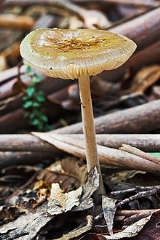
Xerula australis
Encyclopedia
Xerula australis is a species of gilled mushrooms
in the Physalacriaceae
family.
is 5 to 8 cm (2 to 3.1 in) in diameter, and brownish in color. The cap surface is moist, somewhat sticky, with conspicuous striations (grooves) at the margin. The gills have an adnate attachment to the stem, are whitish in color, changing to buff in maturity, sometimes with a tinge of pink in older specimens. The whitish stem
is 8 to 11 cm (3.1 to 4.3 in) by 0.7 to 1 cm (0.275590551181102 to 0.393700787401575 in) thick, covered with small particles (furfuraceous) or small hairs (tomentose); the stem bruises to a gray-tan color. Like other Xerula species, X. australis has a characteristic root-like rhizomorph that extends down in the soil, usually attached to rotting wood under the fruiting body. The spore print
is white.
Microscopic features
The spore
s are ellipsoid, smooth, and hyaline
, with dimensions of 12–16 to 8–11 µm
.
of south-east Queensland
, X. australis may be found growing in large groups on dead roots in the rainforest
, but it is also associated with eucalypt
forests and woodland
.
Agaricales
The fungal order Agaricales, also known as gilled mushrooms , or euagarics, contains some of the most familiar types of mushrooms. The order has 33 extant families, 413 genera, and over 13000 described species, along with five extinct genera known only from the fossil record...
in the Physalacriaceae
Physalacriaceae
Physalacriaceae are a family of fungi in the order Agaricales. Species in the genus have a widespread distribution, but most are found in the tropics, particularly in South-East Asia and Australasia. Molecular studies suggested that Physalacria, formerly the sole genus in this family, is related to...
family.
Description
The capPileus (mycology)
The pileus is the technical name for the cap, or cap-like part, of a basidiocarp or ascocarp that supports a spore-bearing surface, the hymenium. The hymenium may consist of lamellae, tubes, or teeth, on the underside of the pileus...
is 5 to 8 cm (2 to 3.1 in) in diameter, and brownish in color. The cap surface is moist, somewhat sticky, with conspicuous striations (grooves) at the margin. The gills have an adnate attachment to the stem, are whitish in color, changing to buff in maturity, sometimes with a tinge of pink in older specimens. The whitish stem
Stipe (mycology)
thumb|150px|right|Diagram of a [[basidiomycete]] stipe with an [[annulus |annulus]] and [[volva |volva]]In mycology a stipe refers to the stem or stalk-like feature supporting the cap of a mushroom. Like all tissues of the mushroom other than the hymenium, the stipe is composed of sterile hyphal...
is 8 to 11 cm (3.1 to 4.3 in) by 0.7 to 1 cm (0.275590551181102 to 0.393700787401575 in) thick, covered with small particles (furfuraceous) or small hairs (tomentose); the stem bruises to a gray-tan color. Like other Xerula species, X. australis has a characteristic root-like rhizomorph that extends down in the soil, usually attached to rotting wood under the fruiting body. The spore print
Spore print
thumb|300px|right|Making a spore print of the mushroom Volvariella volvacea shown in composite: mushroom cap laid on white and dark paper; cap removed after 24 hours showing pinkish-tan spore print...
is white.
Microscopic features
The spore
Spore
In biology, a spore is a reproductive structure that is adapted for dispersal and surviving for extended periods of time in unfavorable conditions. Spores form part of the life cycles of many bacteria, plants, algae, fungi and some protozoa. According to scientist Dr...
s are ellipsoid, smooth, and hyaline
Hyaline
The term hyaline denotes a substance with a glass-like appearance.-Histopathology:In histopathological medical usage, a hyaline substance appears glassy and pink after being stained with haematoxylin and eosin — usually it is an acellular, proteinaceous material...
, with dimensions of 12–16 to 8–11 µm
Micrometre
A micrometer , is by definition 1×10-6 of a meter .In plain English, it means one-millionth of a meter . Its unit symbol in the International System of Units is μm...
.
Habitat and distribution
X. australis has been recorded growing solitary or in groups, on sandy soil in Southern Australia. Smith (2005) notes that in the Bunya MountainsBunya Mountains
The Bunya Mountains are a distinctive set of peaks forming an isolated section of the Great Dividing Range in southern Queensland. The mountain range forms the northern edge of the Darling Downs near Bell and Dalby. The mountains are south of Kingaroy and just to the south west of Nanango...
of south-east Queensland
Queensland
Queensland is a state of Australia, occupying the north-eastern section of the mainland continent. It is bordered by the Northern Territory, South Australia and New South Wales to the west, south-west and south respectively. To the east, Queensland is bordered by the Coral Sea and Pacific Ocean...
, X. australis may be found growing in large groups on dead roots in the rainforest
Rainforest
Rainforests are forests characterized by high rainfall, with definitions based on a minimum normal annual rainfall of 1750-2000 mm...
, but it is also associated with eucalypt
Eucalypt
Eucalypts are woody plants belonging to three closely related genera:Eucalyptus, Corymbia and Angophora.In 1995 new evidence, largely genetic, indicated that some prominent Eucalyptus species were actually more closely related to Angophora than to the other eucalypts; they were split off into the...
forests and woodland
Woodland
Ecologically, a woodland is a low-density forest forming open habitats with plenty of sunlight and limited shade. Woodlands may support an understory of shrubs and herbaceous plants including grasses. Woodland may form a transition to shrubland under drier conditions or during early stages of...
.

